
Animal Farm is a beast fable, in the form of a satirical allegorical novella, by George Orwell, first published in England on 17 August 1945. It tells the story of a group of anthropomorphic farm animals who rebel against their human farmer, hoping to create a society where the animals can be equal, free, and happy. Ultimately, the rebellion is betrayed and, under the dictatorship of a pig named Napoleon, the farm ends up in a state as bad as it was before.
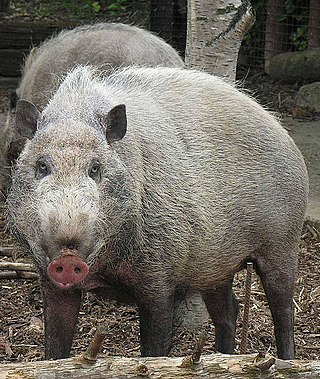
Sus is the genus of wild and domestic pigs, within the even-toed ungulate family Suidae. Sus include domestic pigs and their ancestor, the common Eurasian wild boar, along with other species. Sus species, like all suids, are native to the Eurasian and African continents, ranging from Europe to the Pacific islands. Suids other than the pig are the babirusa of Indonesia, the pygmy hog of South Asia, the warthogs of Africa, and other pig genera from Africa. The suids are a sister clade to peccaries.

The wild boar, also known as the wild swine, common wild pig, Eurasian wild pig, or simply wild pig, is a suid native to much of Eurasia and North Africa, and has been introduced to the Americas and Oceania. The species is now one of the widest-ranging mammals in the world, as well as the most widespread suiform. It has been assessed as least concern on the IUCN Red List due to its wide range, high numbers, and adaptability to a diversity of habitats. It has become an invasive species in part of its introduced range. Wild boars probably originated in Southeast Asia during the Early Pleistocene and outcompeted other suid species as they spread throughout the Old World.
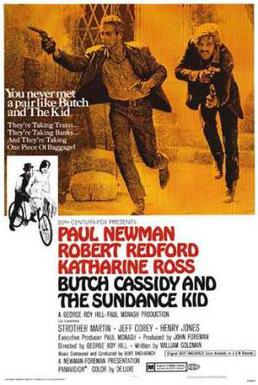
Butch Cassidy and the Sundance Kid is a 1969 American Western buddy film directed by George Roy Hill and written by William Goldman. Based loosely on fact, the film tells the story of Wild West outlaws Robert LeRoy Parker, known as Butch Cassidy, and his partner Harry Longabaugh, the "Sundance Kid", who are on the run from a crack US posse after a string of train robberies. The pair and Sundance's lover, Etta Place, flee to Bolivia to escape the posse.
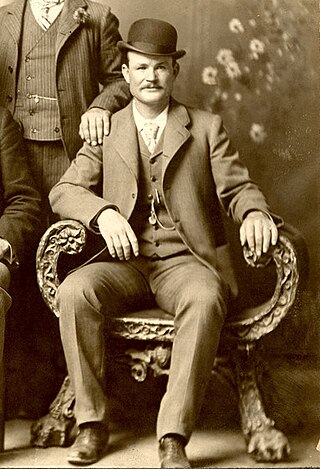
Robert LeRoy Parker, better known as Butch Cassidy, was an American train and bank robber and the leader of a gang of criminal outlaws known as the "Wild Bunch" in the Old West.
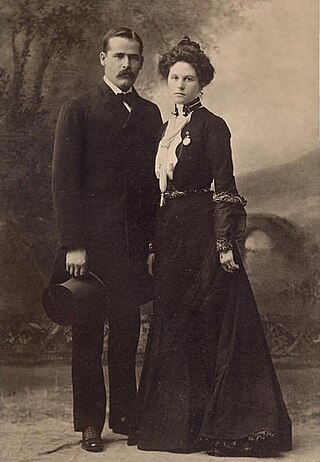
Harry Alonzo Longabaugh, better known as the Sundance Kid, was an outlaw and member of Butch Cassidy's Wild Bunch in the American Old West. He likely met Butch Cassidy during a hunting trip in 1883 or earlier. The "Wild Bunch" gang performed the longest string of successful train and bank robberies in American history. Longabaugh fled the United States along with his consort Etta Place and Butch Cassidy to escape the dogged pursuit of the Pinkerton Detective Agency. The trio fled first to Argentina and then to Bolivia, where most historians believe Parker (Cassidy) and Longabaugh were killed in a shootout in November 1908. However, after digging up their remains and performing DNA testing, the remains were not a match to Butch and Sundance and there are some, including Butch's relatives and descendants, that believe Butch survived the shootout in 1908 and lived under the alias William T. Phillips, a successful business man in Spokane, Washington until his death in 1937.

Whipsnade Zoo, formerly known as ZSL Whipsnade Zoo and Whipsnade Wild Animal Park, is a zoo and safari park located at Whipsnade, near Dunstable in Bedfordshire, England. It is one of two zoos that are owned by the Zoological Society of London (ZSL), a charity devoted to the worldwide conservation of animals and their habitats.

A feral pig is a domestic pig which has gone feral, meaning it lives in the wild. The term feral pig has also been applied to wild boars, which can interbreed with domestic pigs. They are found mostly in the Americas and Australia. Razorback and wild hog are Americanisms applied to feral pigs or boar–pig hybrids.
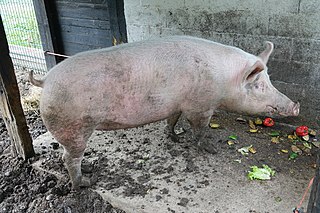
The pig, also called swine or hog, is an omnivorous, domesticated, even-toed, hoofed mammal. It is named the domestic pig when distinguishing it from other members of the genus Sus. It is considered a subspecies of Sus scrofa by some authorities, but as a distinct species by others. Pigs were domesticated in the Neolithic, both in East Asia and in the Near East. When domesticated pigs arrived in Europe, they extensively interbred with wild boar but retained their domesticated features.
Hubert Kinsman Cudlipp, Baron Cudlipp, OBE, was a Welsh journalist and newspaper editor noted for his work on the Daily Mirror in the 1950s and 1960s. He served as chairman of the Mirror Group group of newspapers from 1963 to 1967, and the chairman of the International Publishing Corporation from 1968–1973.

The Tamworth is a British breed of domestic pig. It is the only red-coloured British pig. Its origins are unknown, but it appears to have developed near the town of Tamworth in south-eastern Staffordshire, close to Warwickshire border. It is one of seven British pig breeds listed by the Rare Breeds Survival Trust as 'priority', the highest level of concern of the trust.

Paignton Zoo is a zoo in Paignton, Devon, England. The zoo was started as a private collection by avid animal collector and breeder, Herbert Whitley, in the grounds of his home Primley House. It was opened to the public on a number of occasions, originally as Primley Zoological Gardens, and closed twice due to disputes with the tax authorities. The commercialisation of the zoo came when animals and attractions were relocated from Chessington Zoo during World War II, and the site was named as Devon's Zoo and Circus

South Lakes Safari Zoo is a 51-acre (21 ha) zoo established in 1994 by David Gill, and located in Cumbria, England. Its name refers to its proximity to the Lake District, though it lies entirely within the Borough of Barrow-in-Furness on the outskirts of Dalton.

Boar–pig hybrid is a hybridized offspring of a cross between the Eurasian wild boar and any domestic pig. Feral hybrids exist throughout Eurasia, the Americas, Australia, and in other places where European settlers imported wild boars to use as game animals. In many areas, a variable mixture of these hybrids and feral pigs of all-domesticated original stock have become invasive species. Their status as pest animals has reached crisis proportions in Australia, parts of Brazil, and parts of the United States, and the animals are often freely hunted in hopes of eradicating them or at least reducing them to a controllable population.
Pork in Ireland has been a key part of the Irish diet since prehistory. Ireland's flora and fauna overwhelmingly arrived via a Neolithic land bridge from Great Britain prior to its submerging around 12,000 BP. When the very first hunter-gatherers arrived around 2,000 years later, the local ecosystem largely resembled that of modern Ireland.

Christopher John Pincher is a British former politician and member of the Conservative Party who served as Member of Parliament (MP) for Tamworth from 2010 until his resignation in 2023. Pincher served as Government Deputy Chief Whip, and Treasurer of the Household from 2018 to 2019 and from February to June 2022.

Malmesbury is a town and civil parish in north Wiltshire, England, which lies approximately 14 miles (23 km) west of Swindon, 25 miles (40 km) northeast of Bristol, and 9 miles (14 km) north of Chippenham. The older part of the town is on a hilltop which is almost surrounded by the upper waters of the Bristol Avon and one of its tributaries.
Zoological conspiracy theories involving Israel are occasionally found in the media or on the Internet, typically in Muslim-majority countries, alleging use of animals by Israel to attack civilians or to conduct espionage. These conspiracies are often reported as evidence of a Zionist or Israeli plot.

"Piggate" refers to a claim that, during his university years, the former British prime minister David Cameron inserted his penis and/or scrotum into a dead pig's mouth as part of an initiation ceremony for the Piers Gaveston Society at Oxford University.

















